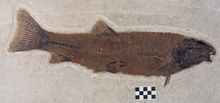Sand fish
| Sand fish | ||||||||||||
|---|---|---|---|---|---|---|---|---|---|---|---|---|

Gonorynchus gonorynchus |
||||||||||||
| Systematics | ||||||||||||
|
||||||||||||
| Scientific name of the family | ||||||||||||
| Gonorynchidae | ||||||||||||
| Fowler , 1941 | ||||||||||||
| Scientific name of the genus | ||||||||||||
| Gonorynchus | ||||||||||||
| Scopoli , 1777 |
The sandfish ( Gonorynchus ) are the only recent genus of the Gonorynchidae family and contain five species . The fish live in the Indo-Pacific and are also found sporadically in the southern Atlantic . Sandfish are fished commercially. In their area of distribution they also have names (translated) such as "Schnabellachs" or "Ratfish" (because of the long, pointed snout).
features
They have an elongated, brownish body, a protruding upper jaw (the maxillary is large, but the premaxillary is very small) and a single barb under the tip of the rostrum , through which the small mouth is completely below (similar to the sturgeon (Acipenseridae) or Chondrostoma ) is. The "lips" are somewhat lobed. Your dorsal fin is very far back and has 10 to 13 fin rays . The pelvic fins are located directly under the dorsal fin , and behind it the anal fin with nine to ten fin rays. A swim bladder is missing (demersal fish! Occurrence up to 700 m depth - eyes large) The jaws are toothless, but on the basihyale (the "tongue") and the entopterygoid (paired) each have a group of rather strong teeth facing each other. It is very noticeable that the sandfish have small ctenoid scales , as one would otherwise only expect from the barbedfish - it is therefore an apomorphism through convergence . Another special feature are "head ribs": the first vertebra is fused with the occiput (head "stiffened" for rummaging or digging in) - its pair of "ribs" are not real ribs (as in the lungfish ), but bones (Patterson and Johnson 1995). Furthermore, Gonorynchus has a simply built, paired epibranchial organ (cruminale) behind the fourth epibranchial of the gill cage (this sym plesiomorphic characteristic of many otomorpha is explained in more detail in Heterotis niloticus ). The Branchiostegal membrane is supported by four (rarely five) rays. The tail skeleton is particularly stiffened by the intergrowth of the most important elements (pu1 + u1 + u2 + un1 + un2 + php + hu1 + hu2) (important for quick start to escape). For further anatomical features see under Notogoneus osculus .
Little is known about the spawning business - at least they are free spawners - although the larvae are found in plankton (near the coast) and sometimes even quite frequently.
The largest species with a length of 60 centimeters is Gonorynchus gonorynchus , a benthic fish that hunts invertebrates at night and burrows in the sand or mud during the day (this is why the sandfish have "glasses", a transparent skin over their eyes).
species
- Gonorynchus abbreviatus Temminck & Schlegel , 1846
- Gonorynchus forsteri Ogilby , 1911
- Gonorynchus gonorynchus ( Linnaeus , 1766)
- Gonorynchus greyi ( Richardson , 1845)
- Gonorynchus moseleyi Jordan & Snyder, 1923
Tribal history

The family Gonorynchidae is fossilized by the four genera Charitosomus , Judeichthys , Ramallichthys and Charitopsis from the chalk of Lebanon, Israel and Germany. Another extinct genus is Notogoneus , which lived in freshwater in North America, Europe, and Australia from the Upper Cretaceous to the Oligocene .
literature
- Joseph S. Nelson, Fishes of the World , John Wiley & Sons, 2006, ISBN 0-471-25031-7
annotation
- ↑ The name means "pointed snout" and was earlier - following the custom to aspirate the initial ῤ - also written "Gonorhynchus" (in this spelling, however, the name refers to a genus of Labeonini today ). Linnaeus named the fish “ Cyprinus gonorhynchus ” in 1766 in a remarkable anticipation of the knowledge of the relationship.
Web links
- Sand fish on Fishbase.org (English)
- Mikko's Phylogeny Archive
